keyword
Forming is type of manufacturing process used very widely through out the world and is one of the old technique. Following are the points we are going discuss in detail in this article:
Content
What is forming? | Fundamentals of metal forming processes
Forming/ Metal forming is a process in which material deforms plastically to get the required shape by application of force in such a way that the stress generated should be greater or equal to yield stress, and simultaneously, it should be less than the ultimate stress of the material.

Types of forming process | Forming process in manufacturing | Bulk metal forming processes | Metal forming processes | Forming operations | Type of forming operations | Different types of forming | | Classification of metal forming process | Types of plastic forming
Metal forming:
1) Bulk metal forming:
- Forging
- Rolling
- Extrusion
- Wire forming
2) Sheet metal forming
- Bending
- Deep cup drawing
- Shearing
- Stretching
- Spinning
3) Advanced metal forming
- Super plastic forming
- Electroforming
- Fine and banking operation
- Hydro forming
- Laser forming
- Powder forming
Microstructure evolution in metal forming processes
When metal forming is carried out, the material goes under very high stress to change it shape. The microstructural change in the material take place. But the formation of crystals will only re arrange if it is hot work, that is worked above recrystallization temperatre. That is the material is heated above its recrystallization temperature and forming is carried out.
Temperature in forming processes | Hot metal forming processes | Cold metal forming processes | Effect of temperature on metal forming process
- Temperature stands to be a very important factor in the manufacturing process, as the material properties are a function of the temperature.
- The working in forming process is divided into three parts on basics of temperature:
- 1. Cold working
- 2. Warm working
- 3. Hot working
- Before defining the above points, let us know what Recrystallization temperature is.
Recrystallization temperature:
- The temperature at which the material will reform the arrangement of its crystal is known as recrystallization temperature.
- It is unique value for each material
- Lead, Tin, Zinc, and Cadmium is the material whose recrystallization temperature is equal to the room temperature and hence work perform on this materials is always hot work.
- Recrystallization temperature ranges from 0.5 to 0.9 times of melting temperature of the material.
Cold working:
- When work is done on the material, when material’s temperature is below the Recrystallization temperature, such work comes under the category of cold working.
- The amount of force and energy required in cold working is very high.
- The accuracy is quite good in cold working as compared to others.
- Properties like Strength and Hardness increase.
- While the properties like malleability and ductility reduce.
- Friction acting in cold working is low.
Warm-working:
- When work is done on the material at a temperature above cold working but less than the recrystallization temperature, it comes under the category of warm working.
- It is preferred over cold working when the amount of force applied is less.
Hot working:
- When work is done on the material, material’s temperature is greater than the Recrystallization temperature, such work comes under the category of hot working.
- The amount of force and energy required in hot working is less.
- The accuracy maintains poor in hot working as compared to others.
- Properties like Strength and Hardness decrease.
- While the properties like malleability and ductility increase.
- Friction acting in hot working is high.
Types of cold forming process
Cold forming techniques: squeezing process, bending process, drawing process, and shearing process.
Squeezing process consist of:
- Rolling process,
- Extrusion process,
- Forging process,
- Sizing process
Bending process consist of:
- Angle bending process,
- Roll bending process,
- Roll forming process,
- Seaming process,
- Straightening process
- Shearing process consist of:
- Sheet metal shear-cutting process,
Blanking.
- Drawing process consist of:
- Wire drawing process,
- Tube drawing process,
- Metal spinning process,
- Sheet metal drawing process,
- Ironing process
Friction and lubrication in metal forming process | Friction in metal forming process
- friction in metal forming take place due to close contact of work piece surface and the tool (die, punch) at high pressure (Also high temperature for some operation).
- This high pressure, high compressive stress and also friction plays a very important role in forming of the product.
- But over 50% of energy is required to overcome tis friction.
- Surface quality is retarded, the tool and die life is reduced.
- To overcome such undesirable effects lubrication is introduced
To overcome the friction lubrication is carried out:
Lubrication in metal forming process | Types of lubricants used in metal forming
Metal forming uses lubrication: water-based, oil-based, synthetic and solid film
- Water based: they good for cooling purpose but are has less lubricity. They are mostly used for high speed application.
- Oil-based: It overcome draw backs of water based lubricant but you lack additive solubility.
- Synthetic: with solubility it also provides good lubricity.
- Solid film: can be used with or without oil/water, mostly used for high pressure, low speed and low temp application.
Advantages and disadvantages of metal forming process
Advantages:
- Material wastage is negligible or zero (As no shear/ cutting action involved).
- Grain can be oriented in required direction
- By cold working strengthens and hardness is increasing, while by hot working the ductility and malleability increases.
Limitations:
- Force and energy required is very high
- Automation is required, therefore it is costly
- Except forging all other process can produce uniform cross section.
- Crossover and undercut are difficult to produce.
Applications of metal forming process
- Channels of direct shape.
- Seamless tubes
- Turbine-rings.
- Hardware products like nail, hails
- Agricultural tools used for sawing and cutting.
- Military products
- Automobile structure parts doors, outer body shield.
- Different plastic products
Rolling
Rolling is a process when the required shape is obtained by passing the material through rollers. This rollers are places with distance between them, which is define by the required thickness of the output product. As material is forced to pass through this gap the high force is also applied by the rollers. The number of rollers depends on application of force.

Rolling is carried out by the following methods:
1.) Hot rolling
2.) Cold rolling
3.) By application of front and back tension
Roll forming (hot)
- Hot rolling is a rolling process (also known as hot working) when the material is heated above its recrystallization temperature before passing it through the rollers.
- Malleability and ductility increase while strength and hardness decreases
- Surface finish and dimension accuracy is poor
- Force and energy required is less as compared to cold rolling
- Friction is high
Roll forming (cold)
- Cold rolling is a rolling process (also known as cold working) when the material is heated below its recrystallization temperature before passing it through the rollers.
- Malleability and ductility decreases while strength and hardness increases
- Surface finish and dimension accuracy is excellent
- Force and energy required is more as compared to hot rolling
- Friction is low
Types of roll forming machine
- Two-high rolling-mills
- Three-high rolling-mills
- Four-high rolling-mills
- Cluster rolling-mill
- Planetary rolling-mill
- Tandem rolling-mill
Sheet metal forming processes and applications | Sheet metal forming processes and die design | Sheet metal roll forming process | Sheet metal forming processes and applications
In forming sheet metal operation the material is deform plastically and no cutting action is carried out.
The force applied in sheet metal forming operation is more than the yield stress so as to carry the deformation but less than the ultimate stress as not cutting action in carried out in forming process.

Different types of sheet metal forming processes | Types of sheet metal forming process | Types of sheet metal forming processes
- Bending
- Deep cup drawing
- Shearing
- Stretching
- Spinning
Bending
Bending is a sheet metal forming operation is where metal is bent in the required direction by applying force with the help of punch and die components. When bending occurs, the outside layers of the sheet go through tension while the inside layer goes through compression. If the stretching is excessive, there might be a chance of shifting the neutral plane towards the center of curvature.

Stretch forming | Types of stretch forming
It is sheet metal forming process in which the selected sheet is stretch and bended continuously over a die to get the required shape. It acquires the shape of the die.
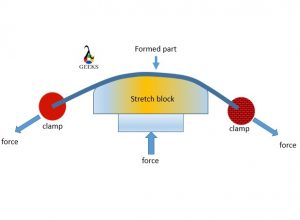
Types of the stretch forming:
- Longitudinal stretch forming
- Transvers stretch forming
Deep drawing metal forming process
Manufacturing of cup from a raw sheet blank with the help of the punch and die is called deep drawing or cup drawing process, Here the material is deformed plastically to get the required shape. It is a sheet metal forming operation hence no cutting action. Punch is used to apply the force to create plastic deformation of the material. And it gets the shape of the die and punches while going through series of bending, stretching, straighten up to produce a vertical deformation wall of a deep-drawn component.
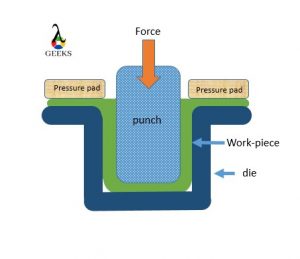
Guerin process metal forming
guerin process metal forming is a subpart sheet metal forming process. In this process the sheet metal is stamped with help punch to get desirable result. It is simple shaping of sheet metal by stamping process.
Metal press forming process
Metal press forming is very simple process in which sheet metal is hold with help of the clamps and shaped with help die and punch. It is same as the stamping process.
Spinning process in metal forming | Spinning process in sheet metal forming
In this process the disc of the metal sheet is used as raw product. It is clamp over the spinning machine against the mandrel. The disc of sheet is pressed against the high speed rotating mandrel with help of the press tool. The symmetric objects are manufactured in this process. It can be carried out on the CNC machine.
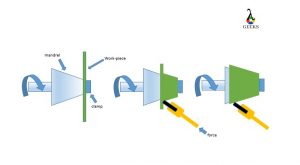
Roll forming process in sheet metal
Roll forming in sheet metal is a process when the required shape/size is obtained by passing the sheet metal through rollers. This rollers are placed with distance between them, which is define by the required thickness of the output product. As material is forced to pass through this gap the high force is also applied by the rollers. The number of rollers depends on application of force
Types of roll forming
- Two-high rolling-mills
- Three-high rolling-mills
- Four-high rolling-mills
- Cluster rolling-mill
- Planetary rolling-mill
- Tandem rolling-mill
Defects in sheet metal forming process
Defects in sheet metal:
Wrinkle: the folding create at inside of the deep drawn component is called wrinkle. It can be eliminated by applying blank holding force along strip plate.
Earing defects: The folding created at the flange end of the deep drawn component is called as the earing defect. It is generated because of circumferential compressive stress or anisotropic properties of material.
It can be eliminated by cutting the material after deep drawing operation by trimming process. The amount of material trimming comes under the trimming allowance.
Scratches: In a deep drawing process because of the friction present between component and the die scratches are generated and it reduces surface quality. It can be eliminated by proper lubrication.
Corner crack or fracture: corner crack or fracture are generated at the bottom of the deep drawn components because of thinning of material and stress concentration.
Orange peel: When annealing of the deep drawn component is done above recrystallization temperature it is observe that the grain get expanded independently and produce coarse size of grain. Which has some structure like peel of orange. Therefore it is called as orange peel.
Advantages and disadvantages of sheet metal forming process | Advantages of sheet metal forming process
Advantage:
- Production rate is high
- Minimum waste
- Uniform density
- Simple process
- High strength
- Good surface finish
Disadvantage:
- High force required
- Heavy machineries
- Automation required
- Somewhat poor in maintain accuracy
Forging
Forging is a process in which material if deforms plastically to get the required shape by applying high compressive force with the help of hammers. The compressive force is applied at a particular location several times to get the final product.
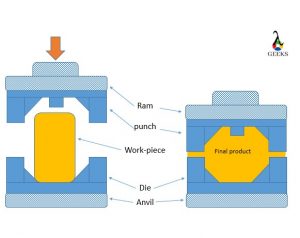
Mostly forging uses a hot working process.
Extrusion | Extrusion metal forming process | Extrusion process in metal forming
Extrusion is a process where a billet is placed inside the stationary cylinder with one end attach to opening with die (Output shape) and another end has a ram to apply the force.
When the force is applied to a solid billet, it acts in a hydrostatic compressive manner.
At one point, this value will reach the flow stress value of the material, where the entire solid material will become extremely soft, like a gel, and will flow through the die, with the shape of the die.
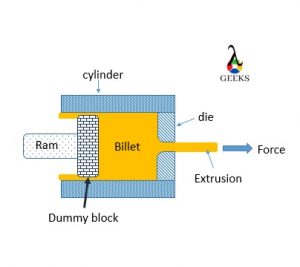
Extrusion types:
1) Forward/direct extrusion: Hydrostatic extrusion.
2) Backward/ indirect extrusion: Impact extrusion or hollow back extrusion.
Wire drawing | Drawing metal forming process
Wire drawing is a process where the billet is given the shape of required output by pulling it through a die rather than Appling force from backward as the extrusion.
A typical wired drawing can de dived in four zone.
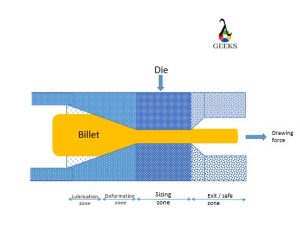
Zone 1: Deformation Zone
The entry diameter of the zone is equal to the rod diameter of the zone, while the end diameter is the diameter of the wire needed to be. Therefore whatever deformation is required to convert the rod into wire takes place in this zone. It is known as the deformation zone. The total included angle of the stented surface of the deformation zone is called as die angle or deformation angle.
Zone 2: Lubrication Zone
This zone is used to supply lubricant to reduce friction and let the process carry out smoothly. If the lubrication is not provided, it dull, rough, and unpleasant surface finish of the wire.
Zone 3: sizing zone
This zone is just used to maintain the same load for some time to convert elastic deformation into permanent plastic deformation.
Zone 4: Exit or Safety zone
This zone is used for collecting high-pressure and high-temperature lubricants.
Punching metal forming process
Punching is process in which punch is used to apply the force on the work piece to get required output and the result may be in form of the cutting/ shear action depending upon a material. It is mostly used to create holes in a metal sheet.
Advanced metal forming processes | Advanced metal forming process
- Super plastic forming
- Electroforming
- Fine and banking operation
- Hydro forming
- Laser forming
- Powder metal forming process
Powder metal forming process
Power metal forming is process in which raw material is in powder form and is well mix for desired output product composition. The powder is push into the die and the punch is used to apply the force and hold it for a time. To increase the density of the product the heat application is also introduced. It is used to manufacturing of self-lubricating bearing.
Blanking metal forming process
Blanking is the specialized precision metal forming process that includes extrusion in cold manner and advanced stamping techniques. It gives clean and good dimension accuracy products, but cost is very high.
Mostly used to manufacture automobile and electronic parts
Types of plastic for vacuum forming
- Acrylonitrile Butadiene Styrene
- Acrylic – Perspex
- Co-Polyester
- Polystyrene
- Polycarbonate
- Polypropylene
- Polyethelene
FAQ’S
What are the different metal forming processes | Types of metal forming process | what are the different types of forming | Metal forming process example
1) Bulk metal forming:
- Forging
- Rolling
- Extrusion
- Wire forming
2) Sheet metal forming
- Bending
- Deep cup drawing
- Shearing
- Stretching
- Spinning
3) Advanced metal forming
- Super plastic forming
- Electroforming
- Fine and banking operation
- Hydro forming
- Laser forming
- Powder metal forming process
Sheet metal forming process
- Bending
- Deep cup drawing
- Shearing
- Stretching
- Spinning
Hot metal forming processes
- When work is done on the material at a temperature greater than the Recrystallization temperature, such work comes under the category of hot working.
- The amount of force and energy required in hot working is less.
- The accuracy maintains poor in hot working as compared to others.
- Properties like Strength and Hardness decrease while the properties like malleability and ductility increase.
- Friction acting in hot working is high.
Metal forming process in automobile industry
Mostly sheet metal forming is used in automobile industry.
What are the defects in metal forming process
Rolling Defects:
Spreading: In a rolling when material spread along the width such defect is called spreading. Generally when thickness of the strip is very high and width is less material spread along the width direction
Alligatoring: Because of the excessive shear along a shear plane of a raw material strip sometimes it gets fracture from the center and creates a similar structure as the mouth of the alligator. Therefore it is called as the alligatoring defect.
Waviness: Because of the anisotropic property of the engineering material a waviness I generated on the rolled components, such defect is called as waviness defect.
Extrusion defects:
Bamboo defects: soft crack along the surface of the component.
Fish Tail: It occurs when hot extrusion is carried out with impurities in the billet. It is also called as pipping defect. It create sink hole at the end of billet.
Center Burst: Center burst are the internal cracks present in the product.
Sheet metal forming defects:
Wrinkle: the folding create at inside of the deep drawn component is called wrinkle. It can be eliminated by applying blank holding force along strip plate.
Earing defects: The folding created at the flange end of the deep drawn component is called as the earing defect. It is generated because of circumferential compressive stress or anisotropic properties of material. It can be eliminated by cutting the material after deep drawing operation by trimming process. The amount of material trimming comes under the trimming allowance.
Scratches: In a deep drawing process because of the friction present between component and the die scratches are generated and it reduces surface quality. It can be eliminated by proper lubrication.
Corner crack or fracture: corner crack or fracture are generated at the bottom of the deep drawn components because of thinning of material and stress concentration.
Orange peel: When annealing of the deep drawn component is done above recrystallization temperature it is observe that the grain get expanded independently and produce coarse size of grain. Which has some structure like peel of orange. Therefore it is called as orange peel.
Is the panel beating metal forming process still in use nowadays
Yes, panel beating is still used now a days. Mostly in small automobile shops to recovery the damage part.
What factors influence formability in metal forming
Properties like, ductility, malleability and formability are important in metal forming.
Is there any difference between sheet metal working process and sheet metal forming process
Yes, in sheet metal work we involve cutting/ shearing apart from forming action but in sheet metal forming the sheet does not go under cutting action. Sheet metal forming is a subpart of metal working.
What is the difference between forming and shaping processes
Forming is the process where the billet is converted and form in a particular shape with the application of compressive force. The volume changes is negligible.
Shaping is the process where the material is cut and machined to get the required output product. The sharp cutting tools are used to machine the material. The volume change take place.
What are some common uses for sheet metal
In automobile, Aircrafts covering.
In domestic appliances: iron covering, washing machine body, fan blades, cooking utensils etc.
For more Article’s related mechanical engineering, visit our website
Read more about Quasi-Static Process.

The lambdageeksScience Core SME Team is a group of experienced subject matter experts from diverse scientific and technical fields including Physics, Chemistry, Technology,Electronics & Electrical Engineering, Automotive, Mechanical Engineering. Our team collaborates to create high-quality, well-researched articles on a wide range of science and technology topics for the lambdageeks.com website.
All Our Senior SME are having more than 7 Years of experience in the respective fields . They are either Working Industry Professionals or assocaited With different Universities. Refer Our Authors Page to get to know About our Core SMEs.